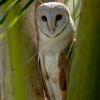Male: sandy-buff above, speckled brown and dull yellow; black gorget and chocolate-black belly. Female: buffy above, streaked and barred darker; black-spotted breast; rufous and black-barred belly and flanks. Pointed central tail feathers and black wing-underside distinctive in flight. Huge gatherings at waterholes in dry season; regularly arrives at water; strictly a ground bird, squatting tight or shuffling slowly; rises en masse.
- Browse
- Gallery
- Checklists
- Topography
- Glossary
- Bibliography
- Feedback
- About Us











